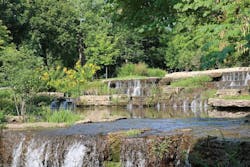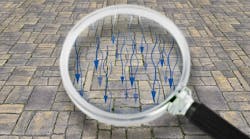Revitalizing Franklin Park
Andy Durham is geotechnical sales manager for AquaBlok Ltd. Durham can be reached at [email protected].
undefinedIn 1992, local Columbus, Ohio, leaders spearheaded an effort to mark the 500th anniversary of Christopher Columbus’ arrival in North America with the AmeriFlora International Horticulture Exhibition. The AmeriFlora team targeted an 88-acre greenspace in downtown Columbus for the venue, as it was an adequate undeveloped area that surrounded the existing Franklin Park Conservatory. As part of the AmeriFlora master plan, the greenspace was to be transformed into a festival site and then returned to the city of Columbus as a public park upon conclusion of the event. Infrastructure, including essential drainage and storm water capacity, was a key component of the festival site upgrade and incorporated into the initial improvements.
The development of the AmeriFlora site (and the then-to-be public Franklin Park) included excavation of a storm water basin system to retain runoff and provide an aesthetic aquatic centerpiece for the exhibition. The system consisted of an upper basin of approximately two acres (with center island), a lower basin of approximately one acre, and approximately 600 linear feet of waterway, including a constructed set of cascading waterfalls to connect the basins. Additionally, an elaborate pumping system was installed to draw water from the lower basin and return it to the upper basin for continuous flow through the cascading waterway. Maintaining a productive organic life cycle and preventing contained storm water from becoming stagnant or septic was an important consideration in the design. Therefore, naturally appearing banks, overflows, islands and other features (including a pump system) were included to support aquatic wildlife amongst abundant vegetation.
Even before the AmeriFlora festival had concluded, it was largely deemed a cultural and financial failure. Since the event failed to embrace and include much of the local demographic (and admission prices were expensive), the festival was not able to generate break-even revenue. To complicate matters, record volumes of rain fell in June and July in the Columbus area, which not only deterred visitors but exceeded the capacity of the basin system, resulting in localized flooding during the event. Corporate sponsors footed the bill to cover festival expenses, and Franklin Park opened to the public as planned in late 1992.
Although popular with local residents, Franklin Park did not receive much other attention after the 1992 event. Flooding was no longer a real issue after it became evident that existing sandy, well-drained soils beneath most of the basin and waterway system resulted in significant infiltration and relatively deficient retention capability. Over the next 24 years, the basins typically held little water, and flow through the constructed cascades was rare. In 2016, the pump system ultimately became inoperable due to the lack of water.
With growth and revitalization of downtown Columbus becoming more prevalent, the city identified the need (and procured funding) for storm water infrastructure upgrades at Franklin Park. The first phase of improvements included $583,000 in engineering and construction costs to restore the pumping system associated with the basins. This work was completed in 2016, but the project did not address the leaking ponds and waterway. Since the pumping system had little water to circulate, it remained relatively inactive. City officials realized that an impervious liner system was necessary to restore the hydraulic system and provide Franklin Park with the retention capacity needed.
Retaining storm water in the basin system was immediately recognized as a challenge. Since sandy soils were pervasive through the area of the park, a significant amount of imported clay material was required to be placed and compacted on the interior bottom surface of both basins. Additionally, massive boulders and stone platforms would need to be removed and replaced within the cascading waterway to accommodate installation of a compacted clay liner. Synthetic polymer (plastic) geomembrane liner was also considered in lieu of a compacted clay liner. However, installing a synthetic geomembrane liner would require extensive dewatering and removal of organic (muck) material and other deposited sediments, as well as intrusive excavation and removal of desirable existing vegetation. Cascade reconstruction over a geomembrane liner was deemed risky, as placement of large stone features was likely to puncture and otherwise damage the underlying material. Finally, the potential degradation of a synthetic geomembrane liner from ultraviolet radiation (sunlight) exposure meant that a substantial repair and replacement budget would be needed for long-term operation.
The City of Columbus Parks and Recreation Department was aware of an alternative solution to compacted clay and synthetic liner that had been successfully installed to seal smaller leaking water features at the downtown Goodale Park Fountain. The product was a “Composite Bentonite Aggregate” material manufactured by AquaBlok Ltd., headquartered in Swanton, Ohio. This material consisted of small gravel-sized stones coated with Bentonite — a naturally occurring, expansive type of clay that is typically used for waterproofing applications either by itself, or as a component of various infrastructure construction products. The material had performed well on the Goodale Park project, and thus became the preferred solution to seal the Franklin Park storm water system.
Composite Bentonite Aggregate, known as “AquaBlok” is made from graded number 8 and number 9 stone, coated with powdered sodium bentonite using a proprietary, non-toxic binder. The finished product is 20% bentonite and 80% stone by weight and is analogous to a chocolate-covered peanut — a centered mass consistently coated with a stable outer shell. Once the material encounters water, the bentonite immediately begins to swell and will expand to fill the voids of the stone, eventually transforming into a self-compacted, impervious mass of clay and aggregate. Bentonite swell occurs in roughly four hours, with maximum impervious performance achieved in 24 hours. The molecular structure of the bentonite allows it to rehydrate again and again, providing a special resiliency not found in manufactured synthetic products.
AquaBlok was able to placed in less-than-ideal subgrade conditions. The improvement project included demucking and excavation of the entire upper basin to provide more capacity and construct a five-foot shelf for safety, should pedestrians enter the pond. Granular bentonite tilled into the soil at the bottom of the upper pond for additional assurance that the beds remained sealed. However, there were many areas along the banks of the basins and connecting waterway that were excavated with minimal subgrade preparation. Portions of the ponds and waterway were saturated during installation, making it difficult to work in at various times. Since only two inches of the materials was specified to provide an impervious surface capable of storm water retention, placement of AquaBlok was achieved rapidly, using innovative installation techniques. Lastly, the material was able to be placed in and around the constructed cascade stonework with a little adjustment and without removal and replacement of any large pieces.
The Franklin Park Cascades and Ponds Restoration project was awarded to Mark Haynes Construction of Norwalk, Ohio, in the Spring of 2019. With the help of AquaBlok and local Reynoldsburg, Ohio, distributor Meredith Brothers Inc., the contractor was trained in the use of a high-speed truck-mounted conveyor with boom to place the material quickly and easily. Upon delivery of the AquaBlok material to the job site in large bulk bags (weighing more than 2,000 pounds), material was loaded into the conveyor machine’s hopper and consistently distributed over the basin surfaces at the requisite thickness. Although it took more than 700 bulk bags of material (containing a little more than 1 cubic yard per bag) to cover the designated area, the placement was completed within two weeks.
The ability of AquaBlok to be placed in less than ideal subgrade conditions saved time and labor on the project. The need to dewater the basin soil prior to construction was unnecessary, and large grading equipment and crews were also not needed. There was no anchor trench to excavate, and no welding, testing and repairing of synthetic geomembrane liner required. The AquaBlok that could not be distributed on the conveyor due to access limitations was placed on surfaces directly from suspended bulk bags and spread by hand (using concrete rakes) in minimal time.
Once the placement was complete, summer rain showers ensured rapid hydration. Initial bentonite swelling yielded a natural appearance, soil-like basin bottom. With only a few high-intensity rainfall events, the basins filled to their design elevations and held. It was immediately apparent that the material had sealed the basin and waterway bottoms and prevented water loss from seepage through the underlying native sandy soil. The AquaBlok seal was also ecologically beneficial as it is composed of stable, naturally occurring, and non-toxic materials that are conducive to vegetative growth over time.
Once the basin system was full again, the revamped pump system began its normal operation. Flow from the upper basin again tumbles down through the cascading channel, over small waterfalls bordered with diverse native and adaptive vegetation. Not only is the water feature tranquil and aesthetic, but it also mimics a natural wetland ecosystem with a flowing stream. The entire configured basin and waterway design is a model of low-impact, sustainable storm water management that has been emulated in various development projects throughout Central Ohio. Ultimately, AquaBlok was a smart choice for this application, and the citizens of Columbus can enjoy the park.


